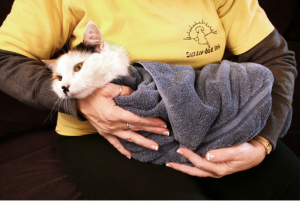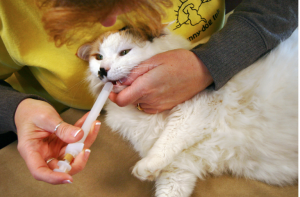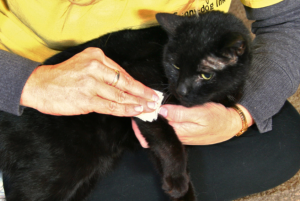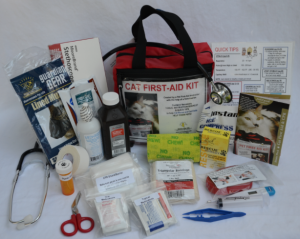First-Aid Tips to Help You Help Your Cat
One Summer morning, two Scottish Fold kittens were playfully exploring their fenced yard when Rudy caught Abigail off guard and bounded at her from behind the rose bushes. As Abby took a tumble landing dazed and confused, a bee flew passed her. The twosome, quickly distracted by this new found fun, attempted to play a game of pounce with the tiny buzzing creature. Fun did ensue for a few moments, but it then turned nasty as the bee planted his stinger right onto the tip of Rudy’s nose! The kitten pawed furiously at his face, and as it began to swell, Rudy started looking more like a bulldog than a fluffy kitty!
INSECT STINGS
Cat generally paw at and remove the insect’s stinger, but should you see one through your cat’s fur coat (or on his nose, lip, paw or elsewhere), scrape it away with a credit card, popsicle stick or similar stiff object. Pulling the stinger with fingers or tweezers could rupture the poison sac allowing the toxin to enter your pet’s body. Administer 1 mg Benadryl per pound of your cat’s body weight (usually comes in 25mg tablets so a smaller half will suffice for most kitties) and apply a cold pack (a bag of frozen peas works well) to any swelling. Should severe swelling or any breathing difficulties develop, get to your Veterinarian at once.
Realizing holding kitty still for any meds or treatment is not an easy chore, so first restrain your cat by shooing her into a bathroom so that she can’t hide under the bed, and control her four claws by swaddling her in a towel. In some cases, kitty may bite if she is in pain, so have a properly fitting cat muzzle available cause if you are bitten, it becomes a human first aid incident and kitty won’t get the prompt care she needs. Well over 50% of cat bites result in humans needing medical care.

“Don’t wish you HAD learned Pet First Aid” was one of the first quotes I received from a student after taking my Pet First Aid Class, and it says it all! Don’t wait until tragedy strikes before you learn animal life-saving skills. According to the American Animal Hospital Association (AAHA), 25% more pets could be saved if their humans attempt even one first aid technique prior to getting them to veterinary care. Knowing what to do at the time of the injury can make a difference — lower body temperature, prevent blood loss, alleviating choking, induce vomiting in poisoning incidents or perform rescue breathing and CPR. Knowing where your nearest Animal ER is, what services they offer and how they accept payment can also be a life-saver.
Before performing any treatment, if you have time to spare (meaning it is not a life-threatening injury), Rescue Remedy® is universally considered safe for most cats. Dribble a few drops (2-3 drops per 10 lbs. of body weight) under her tongue and allow 10 minutes for the mild sedative effects to take place.
INTESTINAL UPSETS
The enticing smell of a barbeque may be hard to pass up, but it is best to stick to your cat’s normal diet to avoid intestinal issues. For upset tummies, administering 1 teaspoon of Mylanta® (other brands may contain too my salicylic acid – aspirin) for a 10-15 lbs kitty through a needless syringe or eye dropper can bring relief. Withhold food to let her stomach rest, but keep water readily available to prevent dehydration. Placing bowls in other locations of the house (away from food) might encourage her to drink. If blood is present in vomit or diarrhea or if these are symptoms of an illness or obstruction, seek immediate veterinary care.

If your cat has swallowed a food item that she should not have (any non-caustic poison that doesn’t burn the esophagus), induce vomiting by administering 1 Tablespoon 3% Hydrogen Peroxide for a 10-15 lbs cat onto the back of her tongue. If this doesn’t cause her to vomit within 30 seconds to 5 minutes, seek immediate veterinary care.
Feeding 1/2 teaspoon daily of pure pumpkin puree (buy canned or rehydrate dry) often aids with fur balls caused by summertime grooming and may firm things up in the case of diarrhea.
BITE WOUNDS
Longer spring and summer are the peak of Kitten Season, but the urge for mating is not always welcomed and may lead to a cat fight! Should your cat receive a bite from another animal, control excess blood loss by applying direct pressure with a clean gauze pad until bleeding stops. You can elevate the limb on a folded towel to assist and if bleeding is on a leg, press on the appropriate pressure point (major artery inside the specific limb — femoral or brachial).

If the wound is only oozing, clean as mentioned below, and if you don’t see a bite mark, don’t assume your cat didn’t get one. Give her a gentle once-over with loving hands, watching her face to notice if you hit a tender spot. Puncture wounds often close quickly trapping bacteria under the skin. Should you find a wound, carefully clip fur from area surrounding it with blunt-nosed scissors, and flush with a Chlorhexidine-type product or water (do not pour peroxide into a deep wound). Examination by your veterinarian is recommended as antibiotics may be needed to prevent an abscess. If however, you suddenly discover an abscess, keep it open to drain and flush it (as above) twice daily for 3 -5 days to rid the bacteria. Rotating Chlorhexidine with cooled black tea is an excellent option. Pat dry and apply an ointment with antibacterial properties. Honey (dark, unpasteurized is a great homeopathic option). An alternative to flushing is to soak a washcloth or gauze in Epsom Salt Solution (1/4 cup Epsom Salt to 1 quart very warm water), squeeze out slightly and place on top of the swollen tissue for 5 minutes three to five times a day. Abscesses often become quite painful and need to be drained by a professional who can also prescribe antibiotics to heal completely.

Cats tolerate heat better than their canine counterparts, but be sure they have plenty of water and cool space to retreat to during this warm time of year. In addition to knowing the location of your nearest Animal ER and acquiring basic Pet First Aid skills, you should have an up-to-date (aka Pet First Aid Kit) for your cat and every week…perform a Head-to-Tail Check-up. Feel for lumps and bumps, notice the condition of her skin and coat and make sure no unusual odor or discharge is coming from any body part. Really get to know your cat because if you learn what is normal for her, you can more quickly determine when something is not quite right and get her the help she may desperately need.

